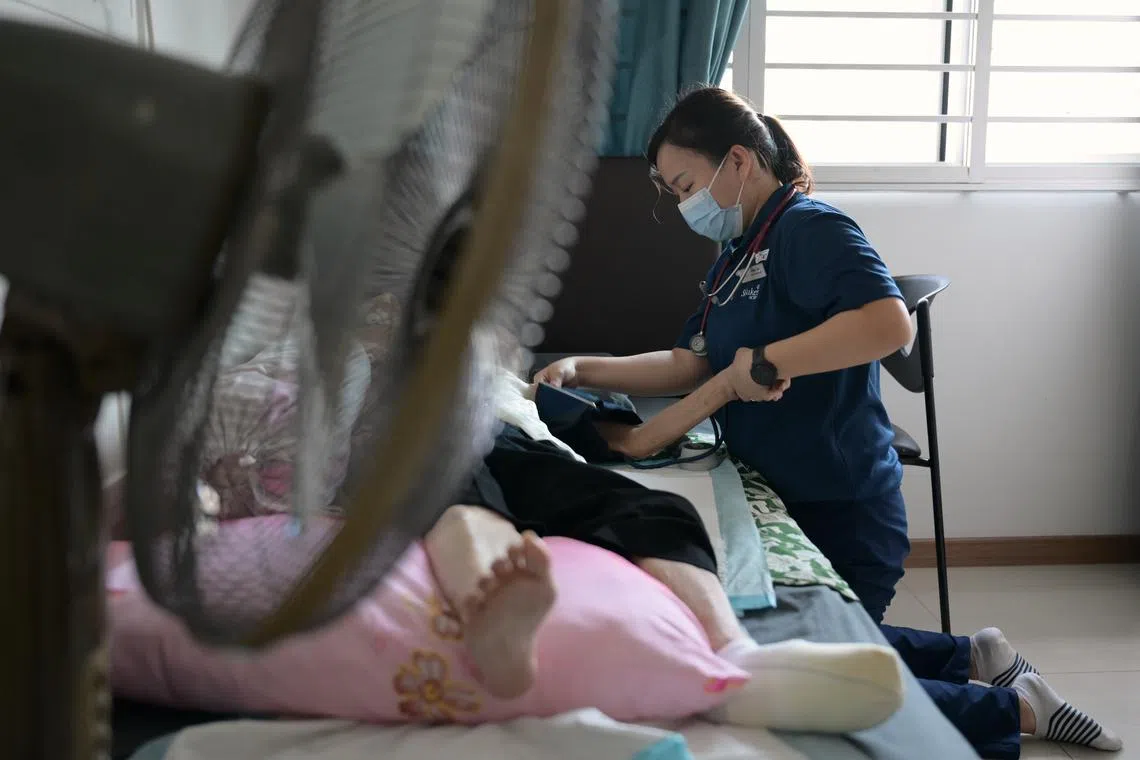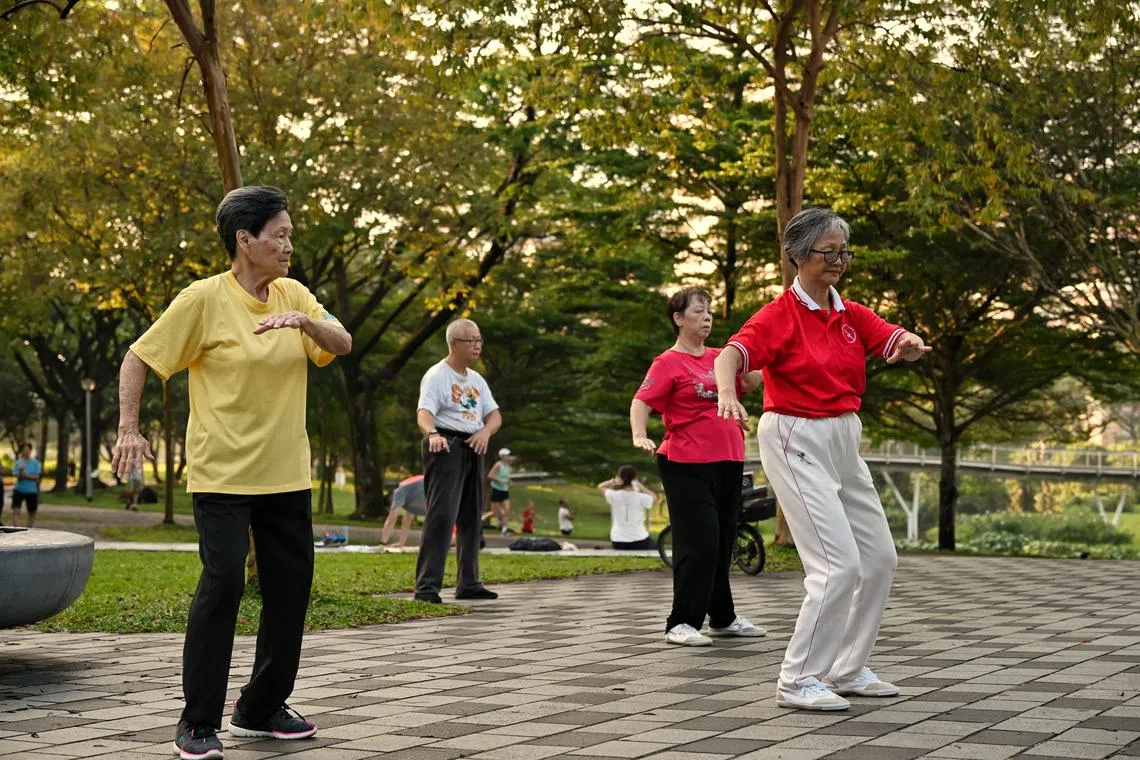CareShield Life not meant to cover entire cost of long-term care: Experts
Sign up now: Get ST's newsletters delivered to your inbox

From 2026, the process and assessment of related long-term care grant schemes will be streamlined.
ST PHOTO: NG SOR LUAN
Follow topic:
- CareShield Life enhancements from 2026 include higher payouts and more government support, yet may only cover a small portion of LTC costs.
- Private add-on insurance offers higher coverage but it is financially infeasible for middle-class families to pre-pay for LTC
- Streamlining claim processes and defining basic LTC costs are crucial, as many lack awareness about expenses and available support schemes.
AI generated
SINGAPORE – CareShield Life, the national long-term care (LTC) insurance scheme, will be enhanced from Jan 1, 2026, with higher monthly payouts and more government support to help policyholders cope with the resulting premium increases.
But it remains a basic scheme that might cover only a small portion of the overall costs associated with LTC needs, and should be viewed as part of a broader support ecosystem, experts said.
“The public should be aware that there is a broader LTC and eldercare support ecosystem they need to tap when the time comes. CareShield Life isn’t designed at all for people to be able to pay for their LTC needs without availing themselves of the broader support schemes,” said Associate Professor of Economics Walter Theseira from the Singapore University of Social Sciences.
On Aug 27, the Ministry of Health (MOH) said that from 2026, CareShield Life’s monthly payouts will grow at a rate of 4 per cent a year,
Policyholders can make claims if they are unable to do at least three of the six activities of daily living (ADLs): bathing, dressing, eating, moving from bed to chair, going to the toilet, and moving around.
Launched in 2020 to replace ElderShield, CareShield Life strengthens the role of insurance in financing LTC. It is mandatory for Singapore citizens and permanent residents born in 1980 or later, and provides higher monthly payouts for life to those with severe disability. The pre-funded insurance scheme is optional for those born in 1979 or earlier.
Pre-paying for a highly probable event
Even with the enhanced payout rate from 2026, Singaporeans need to recognise that CareShield Life provides mainly basic financial support to individuals who need long-term help with daily care, said Dr Joelle Fong, an associate professor at the Lee Kuan Yew School of Public Policy.
“The cash payout from the scheme can certainly help defray some of their LTC out-of-pocket costs, but it may not be sufficient to fully cover all their LTC-related costs,” she noted. In such a scenario, Singaporeans can consider buying private insurance to obtain higher payouts or higher disability coverage, she added.
Mr Christopher Tan, chief executive officer of fee-based wealth advisory firm Providend, said those who seek higher quality of care at private nursing homes would want to add on a supplement plan.
Three private insurers – Singlife, Great Eastern Life and Income – offer optional add-on policies that provide monthly payouts of up to $5,000. Some plans even allow policyholders to make claims when they cannot perform two ADLs, or even one, instead of three.
MOH said one in three people has bought a supplement to CareShield Life or ElderShield.
However, the add-on policies do not come cheap.
“LTC insurance is not insurance in the usual sense (of protecting against a remote risk) many think of, and is instead more like a pre-payment for a highly probable event that, given the high costs, most middle-class families would not be able to afford without subsidy,” said Prof Theseira.
“Given the current policy framework, which provides public subsidies for LTC, I think the financially optimal decision for those in the middle class who would find government-defined LTC to be acceptable is to purchase no supplementary insurance whatsoever, and to rely on government subsidies when needed.”
Families have to ask themselves if it is worthwhile allocating their budget to a supplementary plan that – without extremely high premiums – would never cover the full costs of LTC, he said.
“It may be worth considering a small top-up if one wants protection against partial ADL impairments, but it is unlikely to be worthwhile for many to pay for the full protection.”
Basic costs of care unclear
Though many people will eventually need long-term care, how much it will cost them remains largely unclear.
And while many will underestimate the likelihood of becoming disabled, MOH has said one in two Singapore residents could develop severe disability at some point in their lifetime. It said that among those who develop severe disability, half will have it for at least four to five years. In addition, three in 10 could remain severely disabled for 10 years or more.
This is not simply a problem of ageing, as MOH data showed that the median age of claimants on CareShield Life is 52.
This is why the role the scheme plays in the financing of LTC and its adequacy need to be better understood, said Prof Theseira.
“Most Singaporeans – certainly those who haven’t had a family member go through the process (of planning the care) – have no idea how much LTC costs, or what the framework is for subsidising and providing LTC,” he said. “Even medical professionals and social workers may not know this unless they work in the specific LTC field.”
He noted that recent illustrations from MOH showed that CareShield Life could significantly reduce out-of-pocket LTC costs. This projection, however, relies on specific assumptions: that the claimant meets the prevailing subsidy criteria, that the subsidy level is adequate, and the costs are as projected.
“If those assumptions aren’t satisfied, then CareShield Life is likely to provide almost no help.”

On Aug 27, the Ministry of Health said that from 2026, CareShield Life’s monthly payouts will grow at a rate of 4 per cent a year, from the current 2 per cent.
ST PHOTO: KUA CHEE SIONG
For example, an MOH illustration showed that someone aged 56 or below, with a per capita household income of $1,500 or less, would be billed $1,200 for nursing home care after a 75 per cent subsidy. CareShield Life would cover about half of this cost, with the other half coming out of the patient’s pocket.
If there is no subsidy, the insurance scheme would cover only 15 per cent or less of the out-of-pocket cost, Prof Theseira said.
The issue of costs surfaced at a June roundtable discussion organised by philanthropy organisation Leap201 to explore how national schemes, such as CareShield Life, can better support working families caring for dependants with severe long-term disabilities.
“Beyond medical and rehabilitation fees, there are recurring needs,” said Leap201 founder Michael Lien, who is chairman of Singapore-based investment firm Wah Hin.
“For example, for a stroke patient, potential recurring outpatient costs range from $1,000 to $3,200 per month, to pay for specialised nurses to assist with daily living activities, private transportation and rehabilitative therapy twice-weekly, as typically recommended.”
And families caring for loved ones with dementia often need home-based assistance, psychosocial activities, and respite services, Mr Lien said.
“With a lack of clarity on the basic costs of care and available schemes, it can be overwhelming for families to piece together how CareShield Life payouts and other schemes can help them,” he added. Defining a basic “basket” of LTC needs – including costs, such as transportation, that people may overlook – would give families more certainty, he said.
Making it easier to get LTC support
From 2026, the Government will be streamlining the process and assessment of related LTC grant schemes. Residents who undergo severe disability assessment for an LTC scheme, such as CareShield Life, will also be assessed for other related schemes, such as the Home Caregiving Grant, MOH said.
Still, a concern that Prof Theseira has is that CareShield Life is not fully integrated into the LTC support system in Singapore, meaning that the assessment of subsidies and the need for other LTC is done piecemeal.
It may thus be unclear to families how the plan and other government schemes would come together to support them with LTC needs, he said.
“I went through an LTC experience in my family, and until it happened, I had very little idea what the real costs would be, what I would have to pay for, and what I could get help with,” he said.
“Being able to give families the assurance that, with CareShield Life and government support, they will be able to afford LTC for their loved ones, and having more clarity on what costs families should prepare to pay out of pocket, will be important.”
Mr Lien pointed out that CareShield Life premium subsidies currently extend to households with a property annual value (AV) of up to $31,000. However, other key support schemes, such as the Home Caregiving Grant, still apply a tighter cut-off of $21,000 AV. As a result, a family could qualify for CareShield Life premium subsidy support but not other complementary LTC schemes, he said.
Mr Lien suggested aligning these schemes with the benchmark of $31,000 AV – already adopted for other social support schemes. This would ensure that more families – particularly older Singaporeans living in fully paid-off homes but lacking sufficient income or savings – can receive the support they need.
To make it easier for people to claim from CareShield Life, Providend’s Mr Tan suggested doing away with the need to get an approved assessor to evaluate the condition of the claimant in suitable cases.
For instance, if a hospital doctor certifies a patient as severely disabled during a consultation, the hospital could automatically file the claim. This would expedite payouts, especially for older and less-educated individuals, who might otherwise face delays or miss out on claims due to a lack of awareness, he said.
For greater assurance, Prof Theseira said a potential solution could be to further increase the coverage of CareShield Life. While that would mean higher premiums, it could be acceptable to people if they could pay the premiums with their MediSave monies.
“Many Singaporeans might think they wouldn’t ‘live long enough’ to benefit from CareShield Life or would ‘die instantly’ so they don’t need it, but statistically, neither is true,” he said.
“Whether that is good or bad, the vast majority of Singaporeans would live long enough to be at high risk of needing some LTC.”


